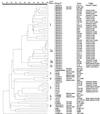Vibrios associated with Litopenaeus vannamei larvae, postlarvae, broodstock, and hatchery probionts
- PMID: 10347048
- PMCID: PMC91383
- DOI: 10.1128/AEM.65.6.2592-2597.1999
Vibrios associated with Litopenaeus vannamei larvae, postlarvae, broodstock, and hatchery probionts
Abstract
Several bacteriological surveys were performed from 1994 to 1996 at different Litopenaeus vannamei hatcheries (in Ecuador) and shrimp farms (in Mexico). Samples were taken from routine productions of healthy and diseased L. vannamei larvae, postlarvae, and their culture environment and from healthy and diseased juveniles and broodstock. In Ecuador, the dominant bacterial flora associated with shrimp larvae showing symptoms of zoea 2 syndrome, mysis mold syndrome, and bolitas syndrome has been determined. Strains were characterized by Biolog metabolic fingerprinting and identified by comparison to a database of 850 Vibrio type and reference strains. A selection of strains was further genotypically fine typed by AFLP. Vibrio alginolyticus is predominantly present in all larval stages and is associated with healthy nauplius and zoea stages. AFLP genetic fingerprinting shows high genetic heterogeneity among V. alginolyticus strains, and the results suggest that putative probiotic and pathogenic strains each have specific genotypes. V. alginolyticus was found to be associated with larvae with the zoea 2 syndrome and the mysis mold syndrome, while different Vibrio species (V. alginolyticus and V. harveyi) are associated with the bolitas syndrome. V. harveyi is associated with diseased postlarvae, juveniles, and broodstock. The identities of the strains identified as V. harveyi by the Biolog system could not be unambiguously confirmed by AFLP genomic fingerprinting. Vibrio strain STD3-988 and one unidentified strain (STD3-959) are suspected pathogens of only juvenile and adult stages. V. parahaemolyticus, Photobacterium damselae, and V. mimicus are associated with juvenile and adult stages.
Figures


Similar articles
-
Differences in the susceptibility of American white shrimp larval substages (Litopenaeus vannamei) to four vibrio species.J Invertebr Pathol. 2001 Nov;78(4):215-9. doi: 10.1006/jipa.2001.5073. J Invertebr Pathol. 2001. PMID: 12009802
-
Molecular variations in Vibrio alginolyticus and V. harveyi in shrimp-farming systems upon stress.Braz J Microbiol. 2015 Oct-Dec;46(4):1001-8. doi: 10.1590/S1517-838246420140410. Epub 2015 Oct 27. Braz J Microbiol. 2015. PMID: 26691457 Free PMC article.
-
Fine-scale succession patterns and assembly mechanisms of bacterial community of Litopenaeus vannamei larvae across the developmental cycle.Microbiome. 2020 Jul 3;8(1):106. doi: 10.1186/s40168-020-00879-w. Microbiome. 2020. PMID: 32620132 Free PMC article.
-
Screening and evaluation of probiotics as a biocontrol agent against pathogenic Vibrios in marine aquaculture.Lett Appl Microbiol. 2007 Aug;45(2):219-23. doi: 10.1111/j.1472-765X.2007.02180.x. Lett Appl Microbiol. 2007. PMID: 17651222
-
New Insights into Pathogenic Vibrios Affecting Bivalves in Hatcheries: Present and Future Prospects.Front Microbiol. 2017 May 3;8:762. doi: 10.3389/fmicb.2017.00762. eCollection 2017. Front Microbiol. 2017. PMID: 28515714 Free PMC article. Review.
Cited by
-
Multiplex PCR using YeaD and 16S rRNA gene to identify major pathogens in vibriosis of Litopenaeus vannamei.Genes Genomics. 2019 Jan;41(1):35-42. doi: 10.1007/s13258-018-0736-7. Epub 2018 Sep 4. Genes Genomics. 2019. PMID: 30182304
-
Deep-sea hydrothermal vent bacteria related to human pathogenic Vibrio species.Proc Natl Acad Sci U S A. 2015 May 26;112(21):E2813-9. doi: 10.1073/pnas.1503928112. Epub 2015 May 11. Proc Natl Acad Sci U S A. 2015. PMID: 25964331 Free PMC article.
-
Las Bolitas Syndrome in Penaeus vannamei Hatcheries in Latin America.Microorganisms. 2024 Jun 12;12(6):1186. doi: 10.3390/microorganisms12061186. Microorganisms. 2024. PMID: 38930568 Free PMC article.
-
Determination of the Infectious Agent of Translucent Post-Larva Disease (TPD) in Penaeus vannamei.Pathogens. 2020 Sep 10;9(9):741. doi: 10.3390/pathogens9090741. Pathogens. 2020. PMID: 32927617 Free PMC article.
-
Vibrio alginolyticus influences quorum sensing-controlled phenotypes of acute hepatopancreatic necrosis disease-causing Vibrio parahaemolyticus.PeerJ. 2021 Jun 1;9:e11567. doi: 10.7717/peerj.11567. eCollection 2021. PeerJ. 2021. PMID: 34141494 Free PMC article.
References
-
- Austin B, Alsina M, Austin D A, Blanch A R, Grimont P A D, Jofre J, Koblavi S, Larsen J L, Pedersen K, Tiainen T, Verdonck L, Swings J. Identification and typing of Vibrio anguillarum: a comparison of methods. Syst Appl Microbiol. 1995;18:285–302.
-
- Chanratchakool P, Pearson M, Limsuwan C, Roberts R J. Oxytetracycline sensitivity of Vibrio species isolated from diseased black tiger shrimp, Penaeus monodon Fabricius. J Fish Dis. 1995;18:79–82.
-
- De Ley J, Cattoir H, Reynaerts A. The quantitative measurement of DNA hybridization from renaturation rates. Eur J Biochem. 1970;12:133–142. - PubMed
-
- Farmer J J, III, Hickman-Brenner F W. The genera Vibrio and Photobacterium. In: Balows A, Trüper H G, Dworkin M, Harder W, Schleifer K-H, editors. The prokaryotes. 2nd ed. III. New York, N.Y: Springer-Verlag; 1992. pp. 2990–2991.
Publication types
MeSH terms
Substances
LinkOut - more resources
Full Text Sources

